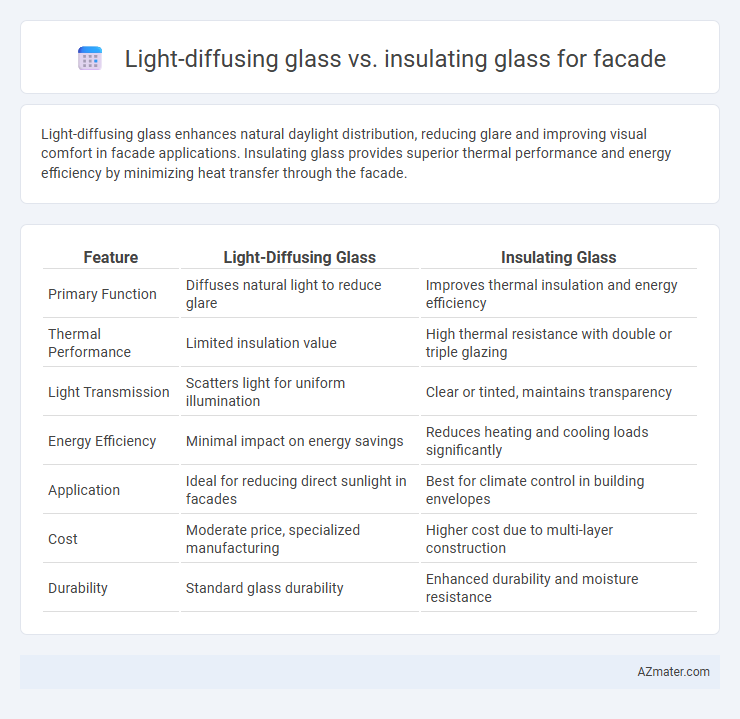Light-diffusing glass enhances natural daylight distribution, reducing glare and improving visual comfort in facade applications. Insulating glass provides superior thermal performance and energy efficiency by minimizing heat transfer through the facade.
Table of Comparison
| Feature | Light-Diffusing Glass | Insulating Glass |
|---|---|---|
| Primary Function | Diffuses natural light to reduce glare | Improves thermal insulation and energy efficiency |
| Thermal Performance | Limited insulation value | High thermal resistance with double or triple glazing |
| Light Transmission | Scatters light for uniform illumination | Clear or tinted, maintains transparency |
| Energy Efficiency | Minimal impact on energy savings | Reduces heating and cooling loads significantly |
| Application | Ideal for reducing direct sunlight in facades | Best for climate control in building envelopes |
| Cost | Moderate price, specialized manufacturing | Higher cost due to multi-layer construction |
| Durability | Standard glass durability | Enhanced durability and moisture resistance |
Introduction to Glass Facades
Glass facades enhance building aesthetics and energy efficiency by combining transparency with thermal performance. Light-diffusing glass disperses sunlight to reduce glare and improve indoor lighting quality, while insulating glass incorporates multiple panes and gas fills to minimize heat transfer and boost insulation. Selecting the appropriate glass type for facades balances daylight distribution, thermal regulation, and visual comfort in modern architectural designs.
What is Light-Diffusing Glass?
Light-diffusing glass is designed to scatter incoming light uniformly, reducing glare and enhancing natural illumination in building facades. Unlike insulating glass, which primarily focuses on thermal performance and energy efficiency by providing a barrier against heat transfer, light-diffusing glass improves daylight distribution without significantly compromising insulation. This type of glass is ideal for facades aiming to optimize visual comfort and create evenly lit interior environments while maintaining modern aesthetic and functional standards.
What is Insulating Glass?
Insulating glass (IG) comprises two or more glass panes separated by an air or gas-filled space, designed to reduce heat transfer and improve energy efficiency in building facades. It enhances thermal insulation by minimizing heat loss in winter and heat gain in summer, contributing to lower HVAC costs and increased occupant comfort. Insulating glass also reduces condensation and noise infiltration, making it a superior choice for energy-efficient and durable facade applications compared to standard single-pane or light-diffusing glass.
Visual Performance Comparison
Light-diffusing glass enhances facade aesthetics by scattering natural light uniformly, reducing glare and creating a soft, even illumination that improves occupant comfort. Insulating glass prioritizes thermal efficiency while maintaining clear visibility, with double or triple-pane constructions minimizing heat transfer but potentially causing reflections that affect visual clarity. The visual performance of light-diffusing glass is superior for applications requiring glare control and privacy, whereas insulating glass excels where transparency and energy conservation are essential.
Thermal Efficiency and Energy Savings
Light-diffusing glass enhances thermal efficiency by scattering sunlight and reducing glare, which minimizes heat buildup and lowers cooling demands in building facades. Insulating glass, often double or triple-glazed with inert gas fills, significantly improves energy savings by reducing heat transfer, maintaining stable indoor temperatures, and lowering heating and cooling costs. Combining light-diffusing properties with advanced insulating glass technology creates facades that optimize natural light distribution and maximize overall thermal performance.
Daylighting and Glare Control
Light-diffusing glass enhances daylight distribution by scattering sunlight evenly across interior spaces, reducing harsh shadows and glare, which improves visual comfort and energy efficiency in facades. Insulating glass primarily focuses on thermal performance, combining multiple glass panes with gas fills to reduce heat transfer but offers limited control over glare and uneven daylight penetration. Selecting light-diffusing glass in facade design optimizes natural light utilization while maintaining glare control, making it ideal for environments prioritizing occupant comfort and sustainable daylighting.
Acoustic Insulation Properties
Light-diffusing glass enhances facade aesthetics by scattering light, but its acoustic insulation is typically lower, providing moderate sound reduction between 25-30 dB. Insulating glass units (IGUs) with laminated or double-glazed configurations significantly improve acoustic performance, achieving sound transmission class (STC) ratings up to 45 dB or higher, making them more effective for noise-sensitive environments. Optimizing facade acoustic insulation involves selecting IGUs with appropriate interlayers and air gap thickness, surpassing the sound attenuation capabilities of standard light-diffusing glass.
Aesthetic and Design Flexibility
Light-diffusing glass enhances facade aesthetics by dispersing natural light evenly, creating a soft, glowing appearance that reduces glare and harsh shadows. Insulating glass prioritizes energy efficiency with multi-pane construction but offers less versatility in light manipulation, often resulting in a more conventional facade look. Designers favor light-diffusing glass for projects demanding dynamic visual effects and innovative light control, while insulating glass suits applications where thermal performance is critical without compromising basic design flexibility.
Sustainability and Environmental Impact
Light-diffusing glass enhances building sustainability by reducing glare and lowering the need for artificial lighting, thereby decreasing energy consumption and carbon emissions. Insulating glass contributes to environmental impact mitigation through superior thermal insulation, minimizing heat transfer and reducing heating and cooling loads. Combining both glass types optimizes energy efficiency and occupant comfort, promoting sustainable facade design with lower environmental footprints.
Choosing the Right Glass for Your Facade
Light-diffusing glass enhances facade aesthetics by softening natural light and reducing glare, improving visual comfort in building interiors. Insulating glass, designed with multiple panes and gas fills, maximizes thermal efficiency and minimizes heat transfer, ensuring energy savings and occupant comfort. Selecting the right glass depends on balancing visual appeal, daylight control, and energy performance requirements specific to your facade design.

Infographic: Light-diffusing glass vs Insulating glass for Facade
 azmater.com
azmater.com